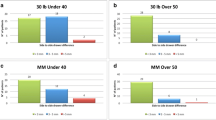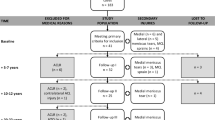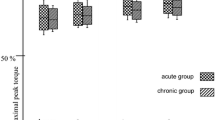Abstract
The aim of the study was to see if delay in anterior cruciate ligament (ACL) reconstruction affects post-reconstruction outcome in recreational athletes. Sixty-two recreational athletes who had arthroscopic ACL reconstructions using quadruple hamstring grafts between 1997 and 2000 were retrospectively evaluated. Patients with less than 2 years’ follow-up, those with multi-ligament injuries, reconstructions for previous failed repairs, those whose injury date was unknown, those with pre-injury Tegner activity level greater than 7 (competitive athletes) and those lost to follow-up were all excluded. Forty-six patients (38 males) were entered. The mean follow up was 38 months and the mean time from injury to index ACL reconstruction was 27 months. Apart from two revisions there were no other significant complications. Forty-one (89%) patients were evaluated in a review clinic. There was a significant improvement in the post-reconstruction Lysholm scores and an improvement in the Tegner scores. The Spearman’s correlation coefficient between postoperative Lysholm score and the delay until surgery was −0.18 and the correlation coefficient between postoperative Tegner scores and the delay until surgery was 0.14. Thirty-five patients returned to sporting activity. Thirty-seven rated their knee as being normal or nearly normal and 35 said that their knee function was as they had expected it to be. Late ACL reconstruction does not adversely affect the outcome in recreational athletes. ACL reconstruction should be offered to these patients as there is a significant improvement in the knee function and patients are satisfied with the results.
Résumé
Le but de cette étude est d'analyser les résultats d'une reconstruction du ligament croisé antérieur retardée chez les sportifs de loisir. Soixante-deux sportifs de loisir ont eu une réparation arthroscopique du ligament croisé antérieur en utilisant les muscles de la patte d'oie, entre 1997 et 2000. Il s'agit d'une étude rétrospective. Ont été exclus de cette étude les patients qui ont moins de deux ans de recul et/ou avec de nombreuses lésions ligamentaires, la réparation du ligament croisé antérieur secondaire à un échec d'intervention antérieure et ceux dont on ne connaissait pas la date exacte du traumatisme initial. Ont été également exclus les athlètes de compétition (7) et les patients perdus de vue. Quarante-six patients (38 de sexe masculin) ont été analysés, le suivi moyen a été de 38 mois et le délai moyen entre le traumatisme initial et la réparation du ligament croisé antérieur a été de 27 mois. En dehors de deux reprises, il n'y a pas eu de complications significatives. Quarante et un (89%) patients ont été évalués cliniquement lors de la revue. Le score de corrélation de Spearman mettant en relation le score de Lysholm post-opératoire et le délai moyen d'intervention a été de −0,18 de même en ce qui concerne le coefficient de corrélation post-opératoire de Tegner et le délai moyen de l'intervention donnant un résultat à 0,14. Trente-cinq patients ont repris leurs occupations sportives. Trente-sept ont estimé que leur genou était redevenu normal ou presque normal et 35 ont estimé que le résultat sur la fonction était celui qu'ils attendaient. Chez les athlètes de loisir une réparation tardive du ligament croisé antérieur n'affecte pas l'avenir du genou, la reconstruction du ligament croisé antérieur entraîne pour ces patients une amélioration significative de la fonction du genou et les patients sont très satisfaits du résultat.




Similar content being viewed by others
References
Andersson C, Odensten M, Gillquist J (1991) Knee function after surgical or non-surgical treatment of acute rupture of the anterior cruciate: a randomized study with long term follow up period. Clin Orthop 264:255–263
Barber FA, Elrod BF, McGuire DA et al (1996) Is an anterior cruciate ligament reconstruction outcome age dependent? Arthroscopy 12:720–725
Casteleyn PP (1999) Management of anterior cruciate ligament lesions: surgical fashion, personal whim or scientific evidence? Study of medium- and long-term results. Acta Orthop Belg 65:327–339
Clancy WG Jr, Ray JM, Zoltan DJ (1988) Acute tears of the anterior cruciate ligament. Surgical versus conservative management. J Bone Joint Surg 70A:1483–1488
Fink C, Hoser C, Hackl W et al (2001) Long-term outcome of operative or nonoperative treatment of anterior cruciate ligament rupture—is sports activity a determining variable? Int J Sports Med 22:304–309
Fisher SE, Shelbourne KD (1993) Arthroscopic treatment of symptomatic extension block complicating anterior cruciate ligament reconstruction. Am J Sports Med 21:558–564
Goradia VK, Grana WA (2001) A comparison of outcomes at 2 to 6 years after acute and chronic anterior cruciate ligament reconstructions using hamstring tendon grafts. Arthroscopy 17:383–392
Hinterwimmer S, Engelschalk M, Sauerland S et al (2003) [Operative or conservative treatment of anterior cruciate ligament rupture: a systematic review of the literature] (in German). Unfallchirurg 106:374–379
Jerre R, Ejerhed L, Wallmon A et al (2001) Functional outcome of anterior cruciate ligament reconstruction in recreational and competitive athletes. Scand J Med Sci Sports 11:342–346
Karlsson J, Kartus J, Magnusson L et al (1999) Subacute versus delayed reconstruction of the anterior cruciate ligament in the competitive athlete. Knee Surg Sports Traumatol Arthrosc 7:146–151
Keene GC, Bieckerstaff D, Rae PJ et al (1993) The natural history of meniscal tears in anterior cruciate ligament insufficiency. Am J Sports Med 21:672–679
Marcacci M, Zaffagnini S, Iacono F et al (1995) Early versus late reconstruction for anterior cruciate ligament rupture. Results after five years of followup. Am J Sports Med 23:690–693
Meighan AA, Keating JF, Will E (2003) Outcome after reconstruction of the anterior cruciate ligament in athletic patients. A comparison of early versus delayed surgery. J Bone Joint Surg Br 85:521–524
Millett PJ, Willis AA, Warren RF (2002) Associated injuries in pediatric and adolescent anterior cruciate ligament tears: does a delay in treatment increase the risk of meniscal tear? Arthroscopy 18:955–959
Novak PJ, Bach BR Jr, Hager CA (1996) Clinical and functional outcome of anterior cruciate ligament reconstruction in the recreational athlete over the age of 35. Am J Knee Surg 9:111–116
Roos H, Karlsson J (1998) Anterior cruciate ligament instability and reconstruction. Review of current trends in treatment. Scand J Med Sci Sports 8:426–431
Shelbourne KD, Patel DV (1995) Timing of surgery in anterior cruciate ligament injured knees. Knee Surg Sports Traumatol Arthrosc 3:148–156
Shelbourne KD, Wilckens JH, Mollabashy A et al (1991) Arthrofibrosis in acute anterior cruciate ligament reconstruction. The effect of timing of reconstruction and rehabilitation. Am J Sports Med 19:332–336
Snyder-Mackler L, Fitzgerald GK, Bartolozzi AR III et al (1997) The relationship between passive joint laxity and functional outcome after anterior cruciate ligament injury. Am J Sports Med 25:191–195
Wasilewski SA, Covall DJ, Cohen S (1993) Effect of surgical timing on recovery and associated injuries after anterior cruciate ligament reconstruction. Am J Sports Med 21:342–388
Author information
Authors and Affiliations
Corresponding author
Rights and permissions
About this article
Cite this article
Tambe, A.D., Godsiff, S.P., Mulay, S. et al. Anterior cruciate ligament insufficiency: does delay in index surgery affect outcome in recreational athletes. International Orthopaedics (SICO 30, 104–109 (2006). https://doi.org/10.1007/s00264-005-0055-x
Received:
Accepted:
Published:
Issue Date:
DOI: https://doi.org/10.1007/s00264-005-0055-x




